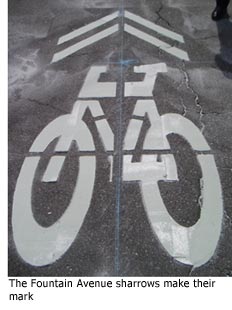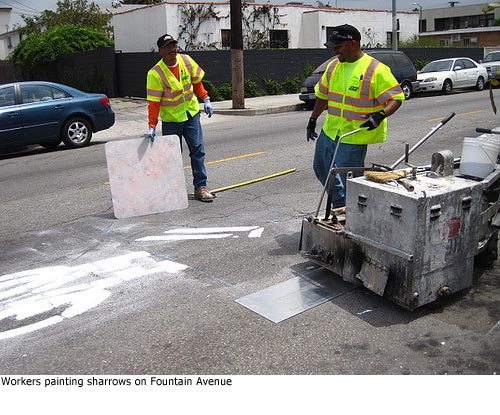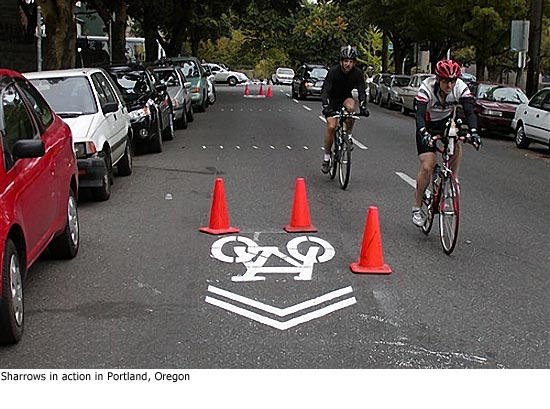Sign of the times for L.A. cyclists
June 30, 2010
Shhh. The sharrows are here.
But don’t look for any big official explanation of the shared bicycle-automobile lanes that have started popping up over the past month on Los Angeles city streets. Although the topic’s been a hot one among local cycling activists and bloggers, city transportation officials say they are trying to keep a low profile for the pilot project until they can study how motorists react to the new lanes.
Even without officially-announced guidelines, people driving or biking over the new stenciled markings on L.A. streets will almost certainly notice they’re seeing something different on the road this summer. What’s less clear is whether they’ll know what the markings mean.
The sharrows—short for “shared-use arrows”—are not intended to replace bike lanes, but to provide a safe bike and car zone on streets that are too narrow for a dedicated bikes-only space. They’re meant to create a place for cyclists to ride out of the dreaded “door zone”—where a parked car door can open suddenly and knock a rider to the ground. Sharrows also remind motorists that the streets are for bicyclists’ use, too. The sharrows don’t change existing rules of the road; when passing a bicycle, motorists would continue to follow the guidance of the DMV driver handbook, which says: “Slow down and pass only when it is safe. Do not squeeze the bicyclist off the road.”
Sharrows are the latest visible sign of the bicyclization of Los Angeles—a movement that is gaining traction in a city known worldwide for its love of, and dependence on, cars.
Despite the stealth rollout, the sharrows’ arrival marks an important moment in L.A.’s transportation evolution, some bike activists say.
“Because L.A. has been historically—and still is—not bike-friendly, and is such a car culture, it really is saying, ‘Yes, we’re going to think about bikes now.’ It is the start of a turning point,” says Aurisha Smolarski, campaigns and communications director for the Los Angeles County Bicycle Coalition.
It’s a turning point that city transportation officials prefer not to discuss publicly until they can complete a study designed to evaluate motorists’ before-and-after behavior in the sharrows zones. The agency does, however, have an announcement about the new sharrows on its main website, with a link to a detailed story and pictures on its bike blog.
Smolarski’s organization, a nonprofit advocacy group that lobbied for the sharrows, has been charged with rolling out an educational effort in August or September, once the city Department of Transportation study is complete.
“Personally, I wish we could do it immediately,” Smolarski says. Instead, informative brochures must take a back seat to word-of-mouth communication for the moment.
(Meanwhile, Long Beach, which beat Los Angeles to the punch with its own sharrows, offers some neighborly help to navigating such lanes in this Q and A, posted under the headline “There’s a new sharrow in town.”)
L.A.’s first sharrows—also known as shared lane markings—were stenciled onto Fountain Avenue between Western and Vermont avenues on June 11. In addition to the coverage on the LADOT Bike Blog, the sharrows also drew the attention of KNBC, which televised this report.
After that, sharrows-sightings turned into something of a popular sport, with wags on Twitter likening it to celebrity-spotting after sharrows popped up on 4th Street between Wilton Place and Commonwealth Avenue.
Next up was Reseda Boulevard, where sharrows were stenciled between Vanowen and Valerio streets.
 In all, six sharrows are planned for the pilot program. There’s no official word on where the others will be, but the LADOT Bike Blog has linked to the L.A. Eco-Village Blog for some information shared by a city bicycle advisory committee member on where the other sharrows are to be located, along with a Google map depiction.
In all, six sharrows are planned for the pilot program. There’s no official word on where the others will be, but the LADOT Bike Blog has linked to the L.A. Eco-Village Blog for some information shared by a city bicycle advisory committee member on where the other sharrows are to be located, along with a Google map depiction.
Sharrows have drawn kudos—and sometimes controversy—in other cities. Since they first were introduced in Denver in the mid-1990s, they’ve been used in Portland and San Francisco as well as a number of Southern California cities, including Glendale, Pasadena and Hermosa Beach, in addition to Long Beach. In June, 2006, they were stenciled on Charles Young Drive, which circles the perimeter of UCLA.
“We have ‘em. We like ‘em. They’ve been successful here,” says Dave Karwaski, UCLA’s planning and policy manager for transportation.
But they’re not universally popular. In addition to motorists concerned about losing road space they’d thought of as theirs exclusively, some fear dangerous encounters between cars and bikes traveling at different speeds on busy thoroughfares. Others worry that local governments will champion sharrows at the expense of other, more costly bicycle improvements, like dedicated bike lanes. And there has been criticism of how the markings have been placed, like in this blog that appeared after the Fountain Avenue sharrows went in. (The Los Angeles County Bicycle Coalition recently wrote an open letter to LADOT general manager Rita Robinson, providing recommendations on sharrows placement.)
Among cyclists, though, perhaps the biggest complaint is how long it all took. A small group of activists, including Smolarski, first proposed the project about five years ago, thinking it would be a quick way to make the city friendlier to bicycles.
On that front, “we were very wrong,” says Smolarski. After several years of trying to push the project forward, it finally took the L.A. City Council and its president, Eric Garcetti, to get things rolling, Smolarski and others say.
Sharrows are likely to be recommended for some streets in unincorporated Los Angeles as part of the new L.A. County Bicycle Master Plan, which is now being drafted.
Matt Benjamin, project lead for the county plan, was one of the activists who first tried to sell the city on doing a sharrows project. He said it’s a “positive development” that the pilot project is now underway in L.A. “Hopefully, they’ll explore new and creative ways of doing shared lane markings in Los Angeles,” Benjamin said, citing Long Beach’s award-winning Green Lane approach to sharrows in Belmont Shore.
Colin Bogart, another of the activists who now is working with the city of Glendale to improve cycling conditions there with the help of a PLACE grant from the county Department of Public Health, says he takes satisfaction in seeing the Fountain Avenue sharrows near his home.
“To finally see paint on the street, I’m excited about it,” Bogart says. “I’m glad that it’s finally being done, and I think that it’s just a start…The city of L.A.—if it’s serious about solving their transportation problems—is going to have to incorporate bikes.”
Posted 6/30/10














 405 bridge work causes a stink
405 bridge work causes a stink

